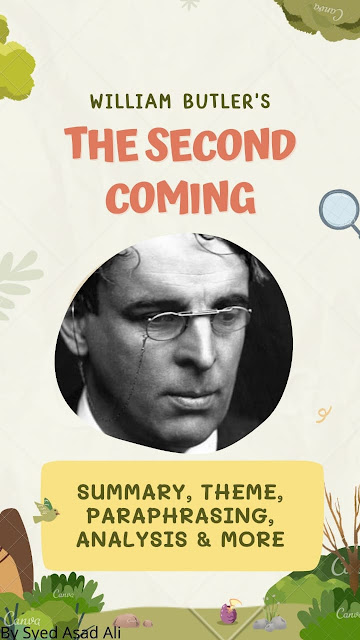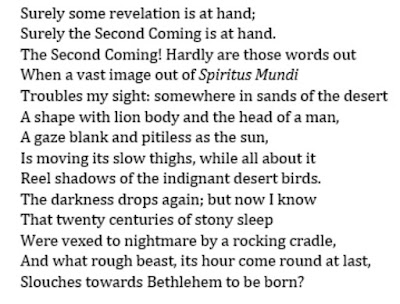Line by line analysis of “The Second Coming”: (Stanzas and their Paraphrasing)
Stanza No. 1
In the first stanza, the poet William Butler Yeats talks
about the ever-increasing and stretching spiritual circles that become bigger
and bigger as they move upward. Each circle in that cone-shaped coil represents
the 200 years of our history. According to him, in each one of those two
hundred years, there always comes a time when humanity almost comes across its
extinction because of its own made-up, chaos, and destruction. The Falcon which
is the man, causing all this destruction, is not being able to recognize his
Creator i.e. the falconer. There also seems to be an imbalance in everything
and because of this imbalance, the forces that are trying to keep everything in
shape and order are now not being able to do so. They are all falling apart.
The only thing that can be seen in this world is the state of disorder because
there is no one there to control it. The violence is getting out of hand and no
one has kept their innocence. Everyone has taken some sort of a part in this
overwhelming chaos, bloodshed, and mass killing. There is little to no hope for
good and its goodness to come and put everything in its right shape and order, while
those who are causing this destruction are doing it a lot more and are taking
way much Advantage than before.
Stanza No. 2
The poet in this stanza says that because of this much
violence, revelation will soon be revealed, by The Second Coming. By “The
Second Coming” he actually means the coming back of Jesus Christ for the second
time. The poet then says that the spirits of the world gave him a vision, which
after seeing disturbed Yeats and he got horrified by it. He says that in the
vision, he saw a creature, probably a sphinx in the middle of a desert, whose
body was the body of a lion but its head was a men's head. The stare it had no
human being would have that stare on his face. It was as if it had no humane
feelings or empathy inside him. That gaze felt nothing for any other human being
in its entire life. The poet resembled that gaze with the Sun that feels
nothing when it pours its hot rays towards people. Yeat says that the Sphinx
that he saw was moving very slowly in the middle of a desert, but its slowness
was increasing the terror and overall suspense. The desert birds he says got
annoyed by the creature’s slow movement and their shadows were also seen on the
land. The desert birds fly in a circle that shows that they are following someone
and that someone is probably going to die soon. This also symbolizes that the
people are going to face a lot more violence and bloodshed than this and a lot
of them will die soon. But then the poet says that his vision ended and there
came complete darkness as if someone dropped the curtains. The vision according
to the poet, gave him some sort of a prophecy that he and the rest of mankind never
knew or thought about it. We all know that twenty centuries before Jesus Christ
died, and now by seeing the earthly situation (WWI, Irish war, atomic bombs,
and all that stuff), the time for Jesus to return has come. According to
Christianity, Jesus will come again and will set everything up to its natural
order and state. His return will be happy and very much soothing. But here he
has used the words “Vexed to nightmare by a rocking cradle”, which means that
the second Coming won't be that much happy, instead, it will be like a
nightmare that nightmare will be like an infant’s nightmare because of which he
gets disturbed and starts to cry when someone moves the baby's bed. And by
looking at the situation, God won't send Jesus to save humanity but instead,
he'll send that rough Beast that will be pitiless and absolutely brutal in
delivering its Justice. Yeat says that the time has come for that Beast to
slowly March from the spiritual world to Bethlehem, where Jesus was supposed to
be born instead.
The Second Coming Summary:
The poet is disturbed by the miserable condition of that
mankind and according to him, he has now no connection with his Creator i.e.
Jesus. Total anarchy has destroyed everything and no one is innocent now no
more. Everyone has played their role towards this great sin. There is no hope
for good no more. The good ones have become weak and the bad ones have
intensified.
Seeing the situation surely a revelation is about to come. According to a vision of the poet, not Jesus, instead, a Sphinx whose body will be a body of a lion but with a man’s head. That rough creature will come and will brutally set everything straight. It will pay no pity to anyone. According to the poet the time has come for that creature to march slowly from the spiritual world to Bethlehem where it will be born instead of Christ.
“The Second Coming” Theme:
The poem talks about the disparity of modern society. The
total anarchy, chaos, destruction and how a modern man profits from the
disorder and benefits from it. The spiritual failure, that the people are now
no longer connected to their Creator i.e. God. And the prediction that if
things go like this then there is a great chance of a Second Coming, a coming
that won’t be of Jesus but of a monster that’ll bring a kind of brutal justice
that nobody has ever seen before.
“The Second Coming” Analysis:
The meter that Yeats used in this poem is Iambic Pentameter.
Figurative devices that he used to beautify this poem are:
1) Anaphora: (The same word coming before two or more lines)
It is used in:
·
line (5-7); starts with
“The”
·
line (9-10); starts with
“Surely”
·
line (14-15); starts with
“A”
2) Epistrophe: (The same word coming at the end of two or more lines)
·
line (9-10); ends with
“Hand”
3) Alliteration: (Words that have the same beginning letter coming in the same line)
·
line (2); Falcon &
Falconer
·
line (7); While & Worst
·
line (13); Sight & Sand
·
line (18); Darkness &
Drop
·
line (19); Stony &
Sleep
·
line (21); Rough &
Round
·
line (22); Bethlehem &
Born
4) Consonance: (Words that have the same ending letter coming in the same line)
·
line (1); Turning &
Widening
·
line (2); Hear &
Falconer
·
line (3); Apart &
Cannot
·
line (4); Loosed &
World
·
line (5); Blood &
Dimmed
·
line (7); Best & Worst
·
line (10); Second &
Hand
·
line (12); Vast & Out
·
line (13); Sight &
Desert
·
line (14); Lion & Man
·
line (17); Indignant &
Desert
·
line (18); Now & know
·
line (19); Twenty &
Stony
·
line (21); What & Last
·
line (22); Slouches &
Towards
5) Simile: (Comparing two things based on the same characteristics)
·
line (15); ….as the sun
6) Metaphor: (The application of one word or a phrase to an object or action)
·
line (1-2); By “Falcon”, he
means the entire Mankind and by Falconer, he means “Jesus”.
·
line (5); By “Blood-dimmed
tide”, he means bloodshed, wars, and violence.
·
line (9); By “Revelation”,
he means the disclosure or the surprising fact.
·
line (21-22); By
“Bethlehem”, he means the place where Jesus was born.
7) Personification: (Giving nonliving things human-like qualities)
·
line (6); He used the word
“Drowned” instead of sinked
8) Enjambment: (Reading two or more lines for better understanding)
·
line (5, 7, 11, 12 &
18)
9) Imagery: (Words that be sensualized)
·
Falcon
·
Falconer
·
Desert
·
Sun
·
Beast
·
Cradle
·
Bethlehem (and more)
10) Paradox: (Talking about two opposite things in the same line)
·
line (7-8); the poet here
talks about the current condition of good and bad people.
11) Allusion: (Reference)
·
line (10); referring to the
second coming of Jesus according to Bible
·
line (12); referring to the
human history
12) Hyperbole: (Exaggeration)
·
Almost all the lines in
this poem have Hyperbole in it
There is also an ambiguity in this poem that we see in its
start as well as in its end. In the start we are not clear about whom the poet
is referring to as a Falcon and the Falconer, is it Christ, God or is it the
natural forces that are keeping it in a complete balance. And in the end, we
are not clear whether the rough beast is a good creature that will come and
make everything fine as it used to be in the past or is it an evil creature
that will come and deliver its brutal justice by pitilessly doing mass-killing
just for the sake of cleansing of the society.
There is also ambiguity on the fact that order and rule were
Yeats’s greatest virtues because he himself wasn’t a very “orderly” man. He was
expelled from the London Theological Society because he refused to follow their
rules. Therefore here in his poem by Falcon not being able to hear the
Falconer, he could also mean that the man is free to do whatever he wants or
free from his past traditions and he doesn’t have to follow any sort of rules
whatsoever.
He used biblical words and phrases such as “Revelation”,
“Second Coming”, and the drowning of innocence which refers to the flood that
came in Noah’s time.
He has also used the themes from his book “A Vision” where
he talks about the society, how they have gone completely mad and uncivilized,
and how they are now different from what they were in the past.
FAQs
Q1) In “The Second Coming” what is symbolized by the “Rough Beast” of line 21?
Ans) The Rough Beast symbolizes the Anti-Christ that will
have its own way of doing justice i.e. sheer bloodshed and mass-killing of the
mankind
Q2) What is the second coming by Yeats about?
Ans) The Second Coming is about the disparity and the
chaotic disorder of mankind. The spiritual decline and the prediction that if
things go like this God will soon unleash His wrath towards us. (See the Theme
to learn more)
Q3) When was the Second Coming by WB Yeats written?
Ans) It was written in 1919 and was published in an American
Newspaper “Dial” in 1920.
Q4) What “genre” is “The Second Coming” by Yeats?
Ans) The “genre” of “The Second Coming” is Blank verse.
Q5) What is the tone of the poem The Second Coming?
Ans) The tone of this poem is terrifying, by making the
people realize and worry in the first stanza what they did and what are their
sins and in the second stanza making it way more terrifying by telling them
that all of their sins will have an ultimate consequence and that consequence
is very soon to come.
Q6) What is the diction of The Second Coming?
Ans) The Diction is totally Apocalyptical.



Comments